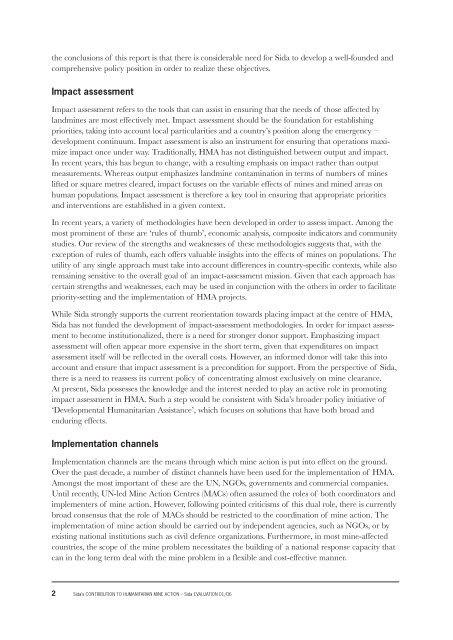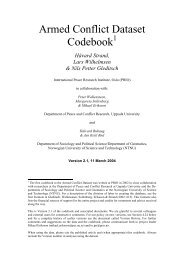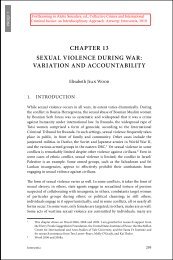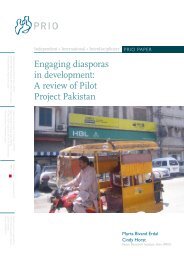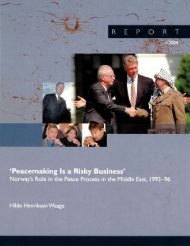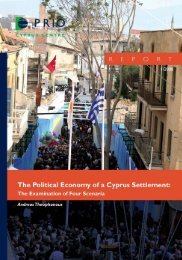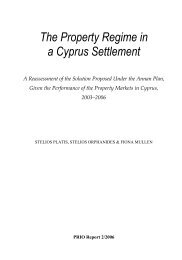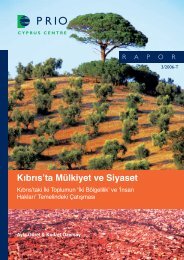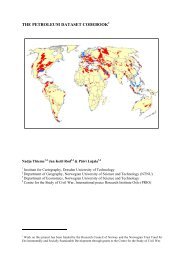the conclusions of this report is that there is considerable need for Sida <strong>to</strong> develop a well-founded andcomprehensive policy position in order <strong>to</strong> realize these objectives.Impact assessmentImpact assessment refers <strong>to</strong> the <strong>to</strong>ols that can assist in ensuring that the needs of those affected bylandmines are most effectively met. Impact assessment should be the foundation for establishingpriorities, taking in<strong>to</strong> account local particularities and a country’s position along the emergency –development continuum. Impact assessment is also an instrument for ensuring that operations maximizeimpact once under way. Traditionally, HMA has not distinguished between output and impact.In recent years, this has begun <strong>to</strong> change, with a resulting emphasis on impact rather than outputmeasurements. Whereas output emphasizes landmine contamination in terms of numbers of mineslifted or square metres cleared, impact focuses on the variable effects of mines and mined areas onhuman populations. Impact assessment is therefore a key <strong>to</strong>ol in ensuring that appropriate prioritiesand interventions are established in a given context.In recent years, a variety of methodologies have been developed in order <strong>to</strong> assess impact. Among themost prominent of these are ‘rules of thumb’, economic analysis, composite indica<strong>to</strong>rs and communitystudies. Our review of the strengths and weaknesses of these methodologies suggests that, with theexception of rules of thumb, each offers valuable insights in<strong>to</strong> the effects of mines on populations. Theutility of any single approach must take in<strong>to</strong> account differences in country-specific contexts, while alsoremaining sensitive <strong>to</strong> the overall goal of an impact-assessment mission. Given that each approach hascertain strengths and weaknesses, each may be used in conjunction with the others in order <strong>to</strong> facilitatepriority-setting and the implementation of HMA projects.While Sida strongly supports the current reorientation <strong>to</strong>wards placing impact at the centre of HMA,Sida has not funded the development of impact-assessment methodologies. In order for impact assessment<strong>to</strong> become institutionalized, there is a need for stronger donor support. Emphasizing impactassessment will often appear more expensive in the short term, given that expenditures on impactassessment itself will be reflected in the overall costs. However, an informed donor will take this in<strong>to</strong>account and ensure that impact assessment is a precondition for support. From the perspective of Sida,there is a need <strong>to</strong> reassess its current policy of concentrating almost exclusively on mine clearance.At present, Sida possesses the knowledge and the interest needed <strong>to</strong> play an active role in promotingimpact assessment in HMA. Such a step would be consistent with Sida’s broader policy initiative of‘Developmental <strong>Humanitarian</strong> Assistance’, which focuses on solutions that have both broad andenduring effects.Implementation channelsImplementation channels are the means through which mine action is put in<strong>to</strong> effect on the ground.Over the past decade, a number of distinct channels have been used for the implementation of HMA.Amongst the most important of these are the UN, NGOs, governments and commercial companies.Until recently, UN-led <strong>Mine</strong> <strong>Action</strong> Centres (MACs) often assumed the roles of both coordina<strong>to</strong>rs andimplementers of mine action. However, following pointed criticisms of this dual role, there is currentlybroad consensus that the role of MACs should be restricted <strong>to</strong> the coordination of mine action. Theimplementation of mine action should be carried out by independent agencies, such as NGOs, or byexisting national institutions such as civil defence organizations. Furthermore, in most mine-affectedcountries, the scope of the mine problem necessitates the building of a national response capacity thatcan in the long term deal with the mine problem in a flexible and cost-effective manner.2 Sida’s CONTRIBUTION TO HUMANITARIAN MINE ACTION – Sida EVALUATION 01/06
Nongovernmental organizations have become the most oft-used implementation channel within mineaction. An emerging, albeit less common channel, is that of national governments. A review of thestrengths and weaknesses of NGOs and governments as implementation channels suggests that NGOsare particularly strong in their ability <strong>to</strong> tailor approaches <strong>to</strong> fit the needs of a given context. NGOs arealso noteworthy for their abilities <strong>to</strong> develop and implement innovative responses and for the mannerin which they have sought <strong>to</strong> institutionalize impact assessment. However, NGOs appear weaker intheir ability <strong>to</strong> coordinate efforts with other humanitarian initiatives and have displayed little capacity<strong>to</strong> build local organizations with the potential <strong>to</strong> sustain HMA activities after their departure. Incontrast, support <strong>to</strong> national governments appears <strong>to</strong> provide a solid basis for creating sustainablenational capacities, as long as that government demonstrates commitment <strong>to</strong> such a goal. At the sametime, governments seem less able <strong>to</strong> accommodate a broader humanitarian agenda, implement impactassessment methodologies and coordinate efforts with non-HMA ac<strong>to</strong>rs.The strengths and weaknesses of specific implementation channels will vary by context. In politicallyunstable situations, NGOs tend <strong>to</strong> be more effective than other channels in the implementation ofHMA. Where governments are stable and effective, NGOs do not offer any significant advantages.Rather, national institutions, through established entities, including both military and civilian institutions,are most effective as long as the relevant organization is legitimate, reliable and technicallycompetent. That the comparative advantage of one type of implementation channel versus another isdependent on a series of contextual fac<strong>to</strong>rs suggests that donor support for a particular channel shouldcome only after a careful review and assessment of the unique features inherent in a specific context.In order <strong>to</strong> ensure that the implementation of HMA is in accordance with a broader humanitarianagenda, the providing of adequate personnel, particularly those with a humanitarian and developmentbackground, should be a prerequisite for funding. Ensuring that steps are taken <strong>to</strong> facilitate the buildingof national organizational capacities with a long-term viability should be seen as a further premise forfunding.CoordinationWhile HMA has frequently been regarded as a highly specialized technical sec<strong>to</strong>r, there is also agrowing realization that it should constitute part of a broader humanitarian initiative. Therefore,it is vital that coordinating mechanisms are in place within mine action as a sec<strong>to</strong>r and between mineaction and other humanitarian efforts. The coordination of HMA is the responsibility of <strong>Mine</strong> <strong>Action</strong>Centres. The cases reviewed here suggest that MACs are relatively effective as HMA coordinationbodies. However, their effectiveness is largely based on a high level of authority, and MACs tend <strong>to</strong>exercise a considerable degree of control over implementing partners. This in turn can restrict thedevelopment of innovative and flexible responses by implementing agencies and may also serve as anobstacle <strong>to</strong> the building of viable national organizations. Currently, the trend is <strong>to</strong> expand the role ofMACs <strong>to</strong> include quality assurance and the accreditation of implementing bodies. Such an expansionimplies an increase in the level of authority exercised by <strong>Mine</strong> <strong>Action</strong> Centres.There is little effective coordination between HMA and other humanitarian assistance. <strong>Mine</strong> actionstill tends <strong>to</strong> be viewed as a technical and specialized sec<strong>to</strong>r, rather than as part of a broader reconstructionand rehabilitation effort. In part, this can be seen as stemming from the preponderance ofmilitary personnel and organizational culture within the sec<strong>to</strong>r. Perhaps more fundamentally, the highlevel of authority exercised by MACs is a hindrance <strong>to</strong> effective coordination between HMA and thebroader humanitarian sec<strong>to</strong>r. The potential for the MAC <strong>to</strong> impose sanctions on those it coordinatestends <strong>to</strong> force organizations involved in mine action <strong>to</strong> focus on coordination within HMA rather thanwith ac<strong>to</strong>rs outside the HMA sec<strong>to</strong>r.Sida’s CONTRIBUTION TO HUMANITARIAN MINE ACTION – Sida EVALUATION 01/06 3
- Page 4: This report is part of Sida Evaluat
- Page 9 and 10: MDDMEDDSMGMMLSWMoPHMOUMPLANATONDING
- Page 14 and 15: A prime concern with Mine Action Ce
- Page 16 and 17: 3. The coordination of mine action,
- Page 18 and 19: an needs and the needs of victims o
- Page 20 and 21: At the same time as Sida has been o
- Page 22 and 23: er, throughout the data collection,
- Page 24 and 25: Donors may feel that the costs of i
- Page 26 and 27: is genuinely new. 8 At an overall l
- Page 28 and 29: The first attempt to apply a form o
- Page 30 and 31: standard for basic impact surveys.
- Page 32 and 33: Community studiesCommunity studies
- Page 34 and 35: and progress monitored in all phase
- Page 36 and 37: 3 Implementation ChannelsOver the p
- Page 38 and 39: cal implementation and management,
- Page 40 and 41: ing that demining has any effect at
- Page 42 and 43: actual response. In an effort to ov
- Page 44 and 45: ecently developed. The approaches t
- Page 46 and 47: A different tool that will be used
- Page 48 and 49: Alternative implementation channels
- Page 50 and 51: appear to have been doing a good jo
- Page 52 and 53: Coordination may at times even be c
- Page 54 and 55: itarian and development effort. Imp
- Page 56 and 57: Two). In terms of coordinating mine
- Page 58 and 59: ased demining of AREA. Another type
- Page 60 and 61: The Kosovo UNMACC took a number of
- Page 62 and 63:
would be accredited and tasked by U
- Page 64 and 65:
programme. The proposal was backed
- Page 66 and 67:
The present landscape of Swedish ac
- Page 68 and 69:
demining purposes. Buoyed by a wave
- Page 70 and 71:
given that SRSA also recruits perso
- Page 72 and 73:
teams. The need for a breeding capa
- Page 74 and 75:
6 RecommendationsIn the preceding c
- Page 76 and 77:
• MACs should operate with agreem
- Page 78 and 79:
7 ConclusionIn this report, we have
- Page 80:
70Appendix 1
- Page 89 and 90:
Ziauddin Operations Officer METADup
- Page 91 and 92:
Bennedich, Claes Department for eva
- Page 93 and 94:
Appendix 3BIBLIOGRAPHYAccelerated D
- Page 95 and 96:
Faulkner, F. & L Pettiford, 1998.
- Page 97 and 98:
McGrath, Rae, 2000. Landmines and U
- Page 99 and 100:
Miscellaneous DocumentsBrady, Justi
- Page 101 and 102:
Appendix 4Sida’s CONTRIBUTION TO
- Page 103 and 104:
Appendix 6• The area must be secu
- Page 105 and 106:
Appendix 7Locality identifier: Dist
- Page 107:
Recent Sida Evaluations00/37:1 Asse


